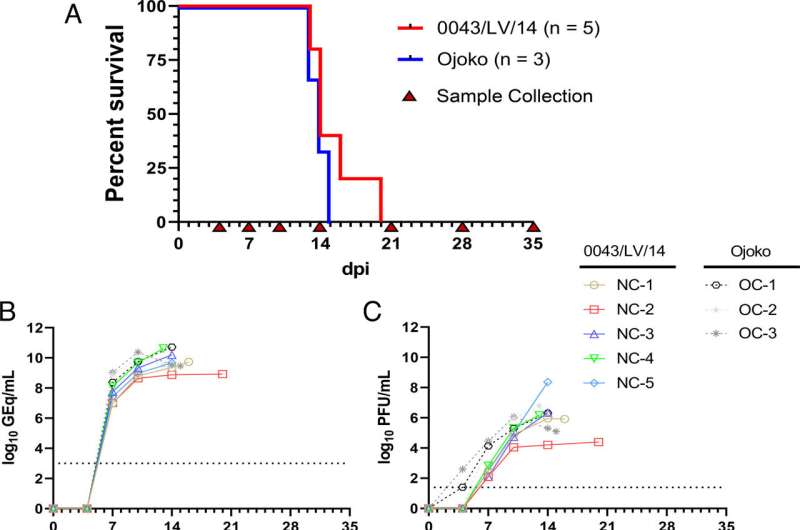This article has been reviewed according to Science X's editorial process and policies. Editors have highlighted the following attributes while ensuring the content's credibility:
fact-checked
peer-reviewed publication
trusted source
proofread
Research uncovers possible monoclonal antibody treatment for Lassa fever

New research out of the University of Texas Medical Branch potentially points to an effective treatment for Lassa fever, a dangerous, often fatal disease common to much of West Africa but considered a major threat to global health.
In a paper published in the journal Proceedings of the National Academy of Sciences, UTMB's scientists document how a new drug from Zalgen Labs successfully cured cynomolgus monkeys infected with Lassa virus.
There currently is no approved treatment for the disease, which is estimated to infect 300,000 to 500,000 people a year across the region and cause at least 5,000 deaths annually. Women and children are at the highest risk from Lassa fever, which is characterized by bleeding and coagulation abnormalities, with overall mortality rates exceeding 25% and reaching 50% during epidemics.
Exposure to infected animals is the most common cause of infection in humans. A recent study that identified the top 50 agents with pandemic potential, Lassa fever was ranked first among known viruses regarded as a threat for zoonotic spillover.
Though less common, human-to-human transmission is caused through exposure to blood or secretions and through sexual contact.
Those in the early stages of the disease often show mild or no symptoms and therefore tend not to seek help until their condition is advanced. About 20% of patients progress to viral hemorrhagic fever.
"Lassa virus has a high level of genetic diversity across much of West Africa," said Dr. Robert Cross, associate professor in the Department of Microbiology & Immunology and one of the authors of the study. "This creates a real challenge for therapeutic developers as it raises the question of whether a single drug could be used to treat all Lassa virus infections."
The UTMB research shows the potential of Zalgen Labs' Arevirumab-3 therapeutic, a monoclonal antibody cocktail, as a treatment against all major strains of the disease in advanced stages.
The study concluded that the Arevirumab-3 therapeutic successfully treated cynomolgus monkeys when administered beginning at advanced stages of disease caused by two different major strains of Lassa virus that were involved in the research.
The results indicated Arevirumab-3 potentially could be used to treat humans infected with Lassa virus.
Arevirumab-3 is on a path toward Investigational New Drug status with the U.S. Food and Drug Administration and toward projected Phase 1 clinical studies to assess its safety and efficacy in healthy human subjects.
"This study represents yet another proof that broad protective treatments, here against the highly complex and variable hemorrhagic fever Lassa virus, can be developed with cutting-edge research within secure high-containment laboratory environments," said Dr. Gary Kobinger, director of the Galveston National Laboratory.
The finding is the result of an ongoing research collaboration between UTMB, Zalgen and Tulane University. UTMB, along with Tulane, is conducting additional studies to further explore the use of Arevirumab-3 against divergent and emerging strains.
"This work is yet another example of our dedication of UTMB and its many collaborative partners, including Zalgen Labs and Tulane University, to refine monoclonal antibody therapies against Lassa virus." Cross said. "It no doubt will serve as further support of the value of continued investment in immunotherapeutics research for the treatment of Lassa fever in humans."
More information: Robert W. Cross et al, A human monoclonal antibody combination rescues nonhuman primates from advanced disease caused by the major lineages of Lassa virus, Proceedings of the National Academy of Sciences (2023). DOI: 10.1073/pnas.2304876120



















